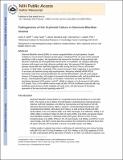Pathogenesis of the Erythroid Failure in Diamond Blackfan Anemia
Author(s)
Sieff, Colin A.; Yang, Jing; Merida-Long, Lilia B.; Lodish, Harvey F
DownloadLodish_Pathogenesis of.pdf (675.3Kb)
OPEN_ACCESS_POLICY
Open Access Policy
Creative Commons Attribution-Noncommercial-Share Alike
Terms of use
Metadata
Show full item recordAbstract
Diamond Blackfan anaemia (DBA) is a severe congenital failure of erythropoiesis. Despite mutations in one of several ribosome protein genes, including RPS19, the cause of the erythroid specificity is still a mystery. We hypothesized that, because the chromatin of late erythroid cells becomes condensed and transcriptionally inactive prior to enucleation, the rapidly proliferating immature cells require very high ribosome synthetic rates. RNA biogenesis was measured in primary mouse fetal liver erythroid progenitor cells; during the first 24 h, cell number increased three to fourfold while, remarkably, RNA content increased sixfold, suggesting an accumulation of an excess of ribosomes during early erythropoiesis. Retrovirus infected siRNA RPS19 knockdown cells showed reduced proliferation but normal differentiation, and cell cycle analysis showed a G1/S phase delay. p53 protein was increased in the knockdown cells, and the mRNA level for p21, a transcriptional target of p53, was increased. Furthermore, we show that RPS19 knockdown decreased MYB protein, and Kit mRNA was reduced, as was the amount of cell surface KIT protein. Thus, in this small hairpin RNA murine model of DBA, RPS19 insufficient erythroid cells may proliferate poorly because of p53-mediated cell cycle arrest, and also because of decreased expression of the key erythroid signalling protein KIT.
Description
Author's Manuscript 2011 February 1.
Date issued
2009-12Department
Massachusetts Institute of Technology. Department of BiologyJournal
British Journal of Haematology
Publisher
Wiley Blackwell
Citation
Sieff, Colin A. et al. “Pathogenesis of the Erythroid Failure in Diamond Blackfan Anaemia.” British Journal of Haematology 148.4 (2010): 611–622.
Version: Author's final manuscript
ISSN
0007-1048
1365-2141